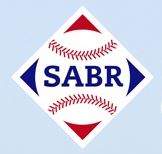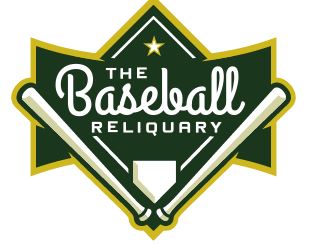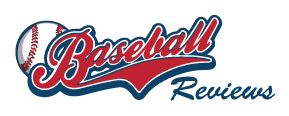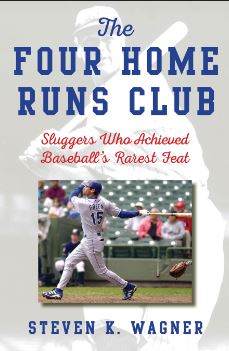 The Four Home Runs Club …
The Four Home Runs Club …
Sluggers Who Achieved Baseball’s Greatest Feat
By Steven K Wagner
Rowman & Littlefield (2018)
$33.00
Spoiler Alert: Baseball Roundtable recommends “The Four Home Run Club” as the ideal Christmas gift for every baseball fan on your list. This is a Grand Slam look at, perhaps, the 18 greatest offensive displays in the history of our national pastime.
“Research is endlessly seductive. Writing is hard work.”
Barbara Tuchman, Best-selling author and Pulitzer Prize winner
When you pick up a Steven Wagner K. Wagner work of prose, it is clear that he is skilled at both research and writing. It is also clear that Wagner has a passion for both story-telling and baseball. Bring all of that together and “The Four Home Runs Club … Sluggers Who Achieved Baseball’s Rarest Feat” is a good read that belongs on every baseball fans bookshelf.
From Bobby Lowe in May of 1894 to J.D. Martinez in September of 2017 – and from players with nicknames like Rocky, the Iron Horse and the Hammerin’ Hoosier to the less likely Scooter and Fat Pat – Steven Wagner’s book takes a look at the eighteen players who have launched an MLB-record four home runs in a single game.
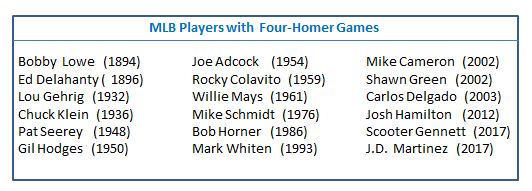 The former United Press International assistant bureau chief put his journalist skills to work in this book, combining ample research with dozens of interviews with individuals who were in the batter’s box, on the mound, in the field or on the bench for the momentous clouts.
The former United Press International assistant bureau chief put his journalist skills to work in this book, combining ample research with dozens of interviews with individuals who were in the batter’s box, on the mound, in the field or on the bench for the momentous clouts.
Wagner adds in descriptions of the ballparks, cultural context (signs of the times) and a look at the lives (before and after their achievement) of the hitters being recognized. And, of course, there is the obligatory statistical section at the end of the book – career statistics for each player and rankings by career home runs, years of service and age at the time of each player’s four-homer binge. There is so much for the baseball fan in the book’s 18 chapters and approximately 200 pages that I considered the opportunity to review “The Four Home Runs Club” to be an early Christmas present.
It’s all there and in a well-written, well-organized, smooth read – in a style that falls somewhere between modern journalism and the more descriptive sports coverage of the past. To give you a better idea of what I’m talking (writing/reviewing) about, here are just a few highlights of what you can expect. In each case, I can truthfully report, you’ll find much, much more.
First, there are those interesting bits of history that can translate into trivia stumpers:
- At 5’10” and just 150 pounds, Boston Beaneaters’ (NL) second baseman Bobby Lowe – the first player to knock four long balls in a single game (May 30, 1984) – was the shortest and lightest ever to achieve the feat. (Lowe, however, may have been a bit heavier post-game. After Lowe’s third home run, Wagner reports, fans showered the field with approximately $160 in coins, a figure equal to “roughly one-third the average annual income for wage earners that year.”)
- The four-homer game Hall of Famer Ed Delahanty notched for the Phillies on July 13, 1896 included two inside-the-park round trippers. Delahanty is the only player to include a shot that did NOT clear the fence in a four-homer contest.
- The Milwaukee Braves’ Joe Adcock, who launched four home runs against the rival Dodgers on July 31, 1954, came the closest to a five-homer game. In his final at bat, Adcock slugged a double to deep right-center. Dodger pitcher Carl Erskine said the ball “hit a rail and came back onto the field. Six inches higher and he would have had five home runs.”
- In his four-homer game (June 10, 1959). The Indians’ Rocky Colavito may have had a bit of extra incentive as a fan dumped a beer on the right fielder after he made a fine running catch on a drive by the home town Orioles’ Albie Pearson in the third inning. As Wagner reports, Colavito spent the game sweaty, sticky and irritated. In Colavito’s own words, “He threw a beer right in my face. I was livid. The nerve of somebody doing that. I’m only doing my job.”
- The Cardinals’ Mark Whiten drove in an MLB-record 12 runs in his four-homer game (September 7, 1993); while the Mariners’ Mike Cameron (May 2, 2002) drove in the minimum four.
- The Blue Jays’ Carlos Delgado (September 25, 2003) is the only member of the Four Home Runs Club to achieve the feat in the minimum four at bats.
- Scooter Gennett (four homers on June 6, 2017) was waived by the Milwaukee brewers (and picked up by the Reds) after Spring Training that season. He went into the game having hit three home runs in his previous 46 games – and having never hit four homers in a month.
You’ll also read about the players lives (and deaths), exploring such topics as Willie Mays’ childhood watching his father playing for the Negro Leagues’ Birmingham Black Barons; Josh Hamilton’s battle(s) with drugs and alcohol; the Bronze Star Gil Hodges won for bravery in World War II; Ed Delahanty’s mysterious and fatal fall/jump from a bridge into the Niagara River at age 35 – and (I repeat) much, much more.
How Young Ryan Gennett became “Scooter”
Excerpt from The Four Home Runs Club …
When the child (Ryan Gennett) got wind that his mother planned to take him to the police station for a lecture on the importance of buckling up in the car, something he had apparently failed to do, he borrowed the alias from the orange-tone Muppet character “Scooter” in hope that it would throw the local authorities off track and keep him out of jail … “I thought I was going to be arrested,” he (Gennett) said. “So, I told the policeman my name was Scooter. After we left there, I didn’t answer to Ryan because I though if I answered to my real name, I might be arrested.”
As Wagner weaves the stories of the Four Home Runs Club, he also takes readers into the ballparks – describing the action inning-by-inning and pitch-by-pitch and providing a well-painted picture of the crowds and the parks themselves. (Consider Philadelphia’s Shibe park, where Lou Gehrig had his four-homer day in 1932. The park held just 23,000 fans and “was built of steel and concrete and boasted an elaborate front entrance and a double-deck grandstand that sported a French-Renaissance portico.” Perhaps more important, the outfield dimensions were not exactly home-run friendly – 378 feet to the left field bleachers, 340 feet to right field and 515 feet to straightaway center.
Wagner further fleshes out each hitter’s story with a look at the signs of the times. Just one example – when examining the Braves’ Bob Horner’s big day (July 6, 1986), Wagner tells readers, “In 1986, the United States needed a happy milestone. The country had largely put behind it the attempted assassination of Ronald Reagan five years earlier, however, two years after that a deadly disease with the curious acronym AIDS was recognized by the Centers for Disease Control and Prevention. If that weren’t enough, the space shuttle Challenger exploded just months before the 1986 baseball season began, killing all seven crew members. A landmark baseball event would surely boost the nation’s spirits.” Wagner sets the stage for each of the 18 four-homer games with a look at not only what was going on in the national pastime, but also with a look at such era-defining factors as global and U.S. news events of the day, popular culture and life-events affecting the players involved.
All of this adds up to what Baseball Roundtable sees as a four-star – or better, a four-homer – recounting of the national pastime’s 18 four-homer games. The Four Home Runs Club is a fast-paced, informative and entertaining read, which – as I said in the beginning of this review – would make a great addition to any baseball fan’s bookshelf.
Other books by Steven K. Wagner:
Perfect: The Rise and Fall of John Paciorek, Baseball’s Greatest One Game Wonder. Review, click here.
Seinsoth: The Life and Rough-and Tumble Life of a Dodger. Review, click here.
About Steven K. Wagner
Steven K. Wagner has worked as a freelance journalist since 1989. He began his career with the Monmouth Sun-Enterprise in Oregon and worked for the Oregon City Enterprise-Courier and Portland Daily Journal of Commerce before joining United Press International. He has also worked for the Portland Oregonian and has freelanced extensively for the Los Angeles Times, Oklahoma City Oklahoman, Seattle Times, Baseball America and numerous other newspaper and magazines. He is also a lifelong fan of the national pastime.
There’s still time to vote in Baseball Roundtable’s unofficial fan Baseball Hall of Fame Ballot. To access the ballot, click here. For BBRT’s “take” on the 2018 nominees, click here.
BASEBALL ROUNDTABLE MAKES TOP 100 BASEBALL BLOG LIST
 Baseball Roundtable has made the Feedspot list of the Top 1oo Baseball Blogs. To see the full list, click here.
Baseball Roundtable has made the Feedspot list of the Top 1oo Baseball Blogs. To see the full list, click here.
I tweet baseball @DavidBBRT
Follow/Like Baseball Roundtable’s Facebook Page here. More baseball commentary; blog post notifications; PRIZES.
Member: Society for American Baseball Research (SABR); The Baseball Reliquary; The Negro Leagues Baseball Museum.
